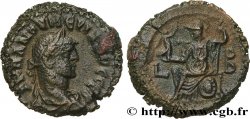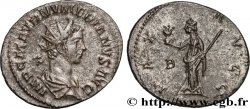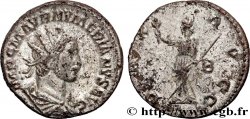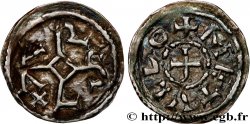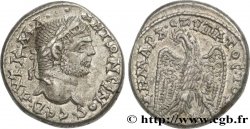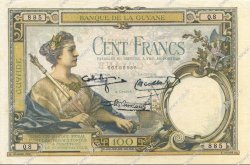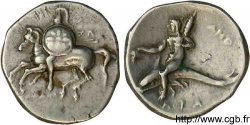v27_0114 - NUMERIANO Aurelianus
MONNAIES 27 (2006)
Prezzo di inizio : 480.00 €
Valutazione : 750.00 €
lotto invenduto
Prezzo di inizio : 480.00 €
Valutazione : 750.00 €
lotto invenduto
Tipo : Aurelianus
Data: début 284
Nome della officina / città: Lyon
Metallo : billone
Titolo in millesimi : 50 ‰
Diametro : 22 mm
Asse di coniazione : 6 h.
Peso : 2,81 g.
Grado di rarità : R3
Officine: 2e
Emission: 6e
Commenti sullo stato di conservazione:
Portrait tout à fait exceptionnel et inhabituel avec une faiblesse de frappe sur la légende. Revers bien venu à la frappe. Défaut de métal à cinq heures au revers. Patine marron foncé avec des reflets métalliques, légèrement piquée
N° nelle opere di riferimento :
Pedigree :
Cet exemplaire provient de la trouvaille n° 2
Diritto
Titolatura diritto : IMP NVMERIANVS AVG.
Descrittivo diritto : Buste radié consulaire de Numérien auguste à droite, vu de trois quarts en avant (H7).
Traduzione diritto : “Imperator Numerianus Augustus”, (L’empereur Numérien auguste).
Rovescio
Titolatura rovescio : PAX - AVGG/ B|-// -.
Descrittivo rovescio : Pax (la Paix) debout à gauche, tenant un rameau d'olivier de la main droite et un sceptre transversal de la gauche.
Traduzione rovescio : “Pax Augustorum”, (La Paix des augustes).
Commento
Avec des restes de l’argenture superficielle. Poids très léger. Le revers présente le même défaut au niveau du A de PAX. Mêmes coins que les exemplaires du Kunsthistorisches Museum de Vienne, collection Trau, n° 70.719, Bastien n° 559a, pl. LVII et que l’exemplaire du trésor de Thibouville n° 2642, Bastien n° 559b, pl. LVII. C’est le troisième exemplaire publié. Daniel Compas fait remarquer que “le buste consulaire H7 est un des plus rares de tout le monnayage lyonnais avant la Réforme. Un exemplaire est connu pour Probus, un pour Carin et deux exemplaires pour Numérien. Notre exemplaire est le cinquième pour ce type de buste (H7)” pour toute la période. Nous avons donc un seul coin de droit et de revers pour trois exemplaires. Prendra le numéro 559c dans le Supplément III.
With remnants of the superficial silvering. Very light weight. The reverse has the same defect at the A of PAX. Same dies as the examples in the Kunsthistorisches Museum in Vienna, Trau collection, no. 70.719, Bastien no. 559a, pl. LVII and as the example from the Thibouville treasure no. 2642, Bastien no. 559b, pl. LVII. This is the third example published. Daniel Compas notes that “the consular bust H7 is one of the rarest in all the Lyon coinage before the Reformation. One example is known for Probus, one for Carinus and two examples for Numerianus. Our example is the fifth for this type of bust (H7)” for the entire period. We therefore have a single obverse and reverse die for three examples. Will take the number 559c in Supplement III
With remnants of the superficial silvering. Very light weight. The reverse has the same defect at the A of PAX. Same dies as the examples in the Kunsthistorisches Museum in Vienna, Trau collection, no. 70.719, Bastien no. 559a, pl. LVII and as the example from the Thibouville treasure no. 2642, Bastien no. 559b, pl. LVII. This is the third example published. Daniel Compas notes that “the consular bust H7 is one of the rarest in all the Lyon coinage before the Reformation. One example is known for Probus, one for Carinus and two examples for Numerianus. Our example is the fifth for this type of bust (H7)” for the entire period. We therefore have a single obverse and reverse die for three examples. Will take the number 559c in Supplement III








 Segnalare un errore
Segnalare un errore Stampate la pagina
Stampate la pagina Condividi mia selezione
Condividi mia selezione Fai una domanda
Fai una domanda Consegnare / vendere
Consegnare / vendere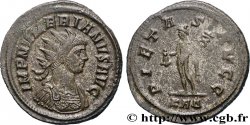
 Descrittivo
Descrittivo